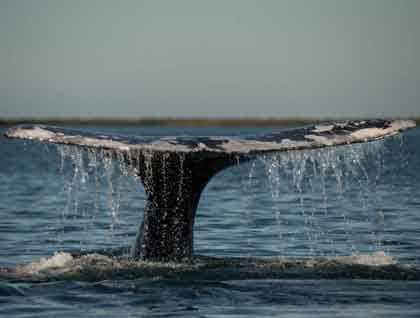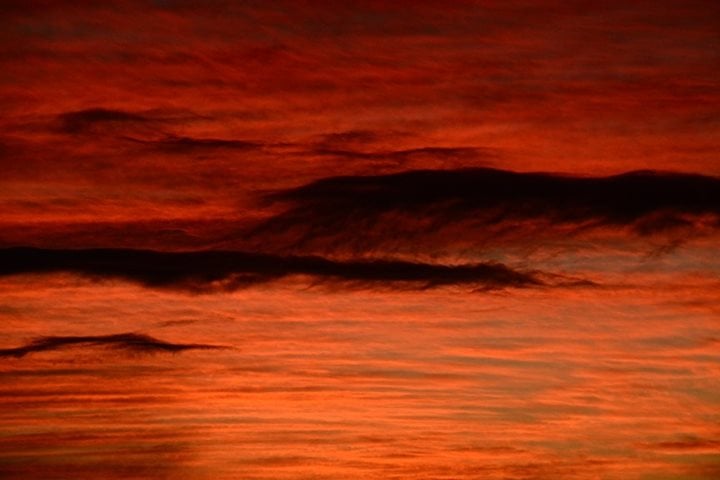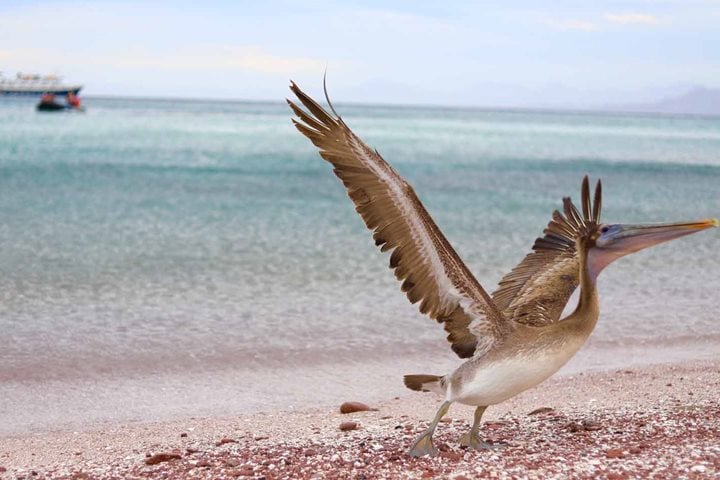We awoke this morning at the little town of Puerto Escondido, all of us ready in mind and heart to travel the distance across the peninsula of Baja California Sur to Magdalena Bay on the Pacific side. Our prize for the two-and-a-half hour van ride would be whales, gray whales. If Baja is a synonym for anything, it is whales, and the whale of greatest fame is the gray. Each year the entire population of breeding gray whales migrates down the coast of the western United States to reach the calm peaceful waters of the lagoons of Baja California Sur to give birth to their young. The whales that are not going to be giving birth come here to mate. It is the longest migration of any mammal on the planet, and like the great migration of wildebeest in Tanzania, one of the true wildlife spectacles everyone should see at least once in their life.
When we arrived at the dock where we would board our pangas (the dories the Mexican fishermen use to ply their trade) everyone made a dash to collect lifejackets and be assigned to the panga they would watch whales in. Soon we were motoring through the waters of Mag Bay, everyone searching for the telltale sign of whales, spouts. No matter how much we strained our eyes, they could not replace the experienced lookout of our panga drivers. In my panga, our captain, Miguel, called out “whale,” and all raised to their feet hoping for their first glimpse of the gray whale. “Mama and baby” said Miguel and a sigh came over the crowd. On our way to the mother-calf pair we spotted another whale by herself, (I say herself because I am making the assumption that it is a female that has yet to deliver her child), and as we watched she raised her fluke, which made all of us shout for joy. I had just finished explaining that although gray whales do show their flukes on a dive, that often in the breeding lagoons the water is shallow and they do not need to arch their body in such a way that that their tails come above the surface. I explained that it happens, but not to expect it from most of the whales we would be seeing. I was so happy to eat my words, and since it is not as common in the lagoons, we decided to follow her in the hopes she would show her tail again. She did not disappoint us and she continued to fluke as it is called as she swam to the northern end of the lagoon. We did not stay long with her, only enough that each of us had gotten an image of the event.
We caught up with our cow-calf pair and were joined by another panga from our group. Each of our little boats seemed enough of an oddity to the young whale that we all got very close encounters with the pair of cetaceans. Our hope was that the calf would be curious enough to give us the opportunity to reach out and touch the newborn calf, but it was not the time for it to happen. The calf was but a few days old, and those whales that seek out the company of humans tend to be a little older. It did not matter; we were there, alongside a mother gray whale and her newborn calf. There were ooohs and ahhhs were heard over time as the calf showed its tiny body at the surface, gasps of disbelief were heard when the mother burst to the surface with an explosion of breath. We went from one pair of whales to another, until it was time for us to return to port for our appointed lunch.
At lunch it was announced that we would have another opportunity to go whale watching again after our meal. Applause was given all around.
In the afternoon the wind had increased and the still waters we had during our morning were no longer with us. On this afternoon, the whales showed us how lucky we were in the morning. It was still incredible to be able to watch these magnificent animals cruising the waters of Mag Bay, but the close approaches were not to be had. It is amazing how different one whale watch can be from the next, even in the course of just a few hours. But where one highlight is gone, another replaces it, and the light from the sinking sun lit up the dunes that lined the bay. The long shadows on the golden sand was spectacular, one of the guests commented that he would have come just for the view of the dunes in the late afternoon light. Herons and egrets lined the shore, pelicans dove for the day’s last meal of sardines, and western grebes disappeared beneath the water as if they were never there to begin with.
We watched for a while, and then it was time to return to National Geographic Sea Bird once again. The ride back to our ship was a quiet one, some of thinking about the experience we had during the day, others too tired to stay awake dozed as we drove. We returned to a Mexican feast back on the Sea Bird, and our day with the “whales of the desert” ended as we retired to our bunks, ready to see what the next day would have in store.







